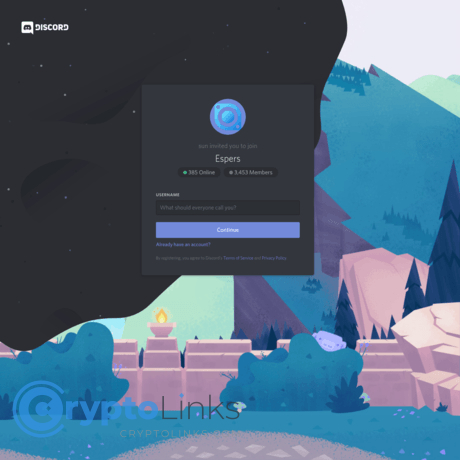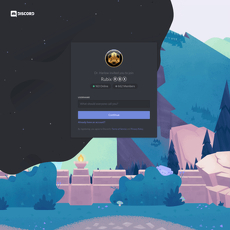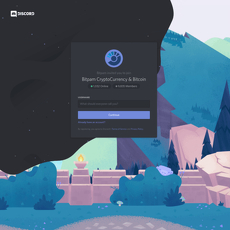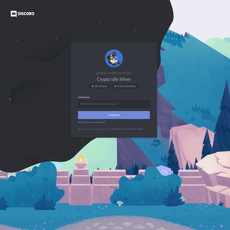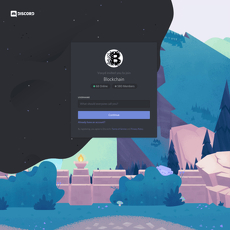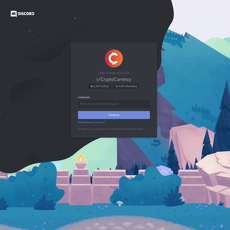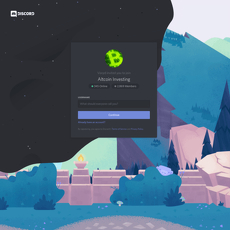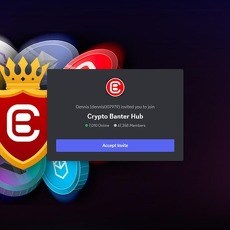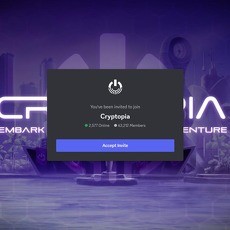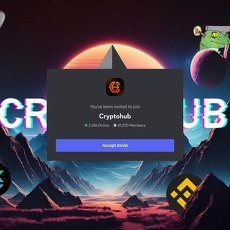Espers Review
Espers
discordapp.com
Espers Discord Review Guide: Everything You Need to Know (FAQ Inside)
Ever joined a crypto Discord thinking you’ll get signal, and instead you drown in dead channels, off-topic spam, and “soon” updates? Wondering if the Espers Discord is any different—and if it’s actually worth your time?
You’re in the right place. I’ve spent years poking around crypto servers that look alive from the outside but feel abandoned once you’re inside. In this guide, I’ll show you how Espers’ server stacks up, what to check first, how to spot red flags quickly, and where the value is (if it’s there).
Why Most Crypto Discords Waste Your Time (And How to Avoid That Here)
Here’s the pattern I see over and over:
- Outdated servers: Announcement channels go silent for months, but the invite link still circulates.
- Confusing roles: You can’t tell who’s staff, who’s a bot, or who’s pretending to be support.
- Broken information flow: Multiple “announcements” channels with conflicting messages, and no single source of truth.
- Ghost communities: Active member count looks decent, but real chat volume is near zero.
- Security tripwires: Fake support DMs, phishing links, and “urgent” wallet requests after you say hello.
This isn’t just annoying—it’s risky. The U.S. Federal Trade Commission has repeatedly warned that social platforms are a major entry point for investment scams, and crypto is a favorite target. Discord isn’t the problem; poorly moderated Discords are.
“If you can't tell who’s in charge, when the last legit update happened, or where to get verified news, you’re not in a community—you’re in a liability.”
What I’ll Help You Do (Fast)
Think of this as your quick-start checklist for Espers on Discord. I’ll show you how to:
- Enter cleanly: Use the right invite link, pass verification, and get the roles that actually unlock value.
- Locate signal: Find the one announcements channel that matters, plus dev updates and support routes.
- Check health in minutes: Scan message timestamps, mod response times, and pinned items to see if the server’s active.
- Stay safe: Avoid DM traps, verify links, lock down your account, and spot fake “support” right away.
- Decide quickly: Is this worth joining now, watching later, or skipping? You’ll know without wasting hours.
Who This Is For
- Curious newcomers: You just heard about Espers and want a no-nonsense way to explore the community.
- Returning holders: You were around before, you’re not sure what’s changed, and you want a clean re-entry.
- Researchers and due-diligence folks: You need a fast read on activity, moderation quality, and trust signals.
What I Tested
- Invite access: Does the link get you in, or do you hit rate limits/expired invites?
- Onboarding flow: Is there a captcha or role gate? Are rules clear? Do roles map to useful channels?
- Channel quality: Is there a single source for official updates and a separate place for chat, or is it all blended?
- Announcements cadence: Are updates recent and consistent—or sporadic and vague?
- Moderation and safety: Do mods appear in threads? Are scam posts removed quickly? Are pins kept current?
- Support experience: Is there a ticket system? Are response times reasonable?
- Community vibe: Are people helping each other, or is it mostly price spam and off-topic noise?
What You’ll Walk Away With
- A fast yes/no: Whether joining the Espers Discord is worth it for you right now.
- A survival kit: The handful of channels and settings that keep you informed without drowning in noise.
- A safety checklist: The habits that protect you from the most common Discord scams.
Curious what Espers actually is, who’s behind it, and why the Discord matters in the first place? In the next section, I’ll give you a quick snapshot so you can judge the server with context. Ready for a 60-second tour of the project before we step inside the channels?
What Is Espers? Quick Snapshot and Why the Discord Matters
Here’s the short version: Espers is a crypto project with a community-first heartbeat, and its Discord is where that pulse is easiest to feel. If you want real-time context—what’s shipping, what’s paused, who’s helping users, and whether momentum is rising or fading—the server is the quickest signal. Think of it as the project’s living room: announcements, dev notes, support threads, and community coordination all pass through there first or close to it.
“In crypto, silence isn’t neutral; it’s momentum in reverse.”
Why does this matter? Because the difference between a project that’s building and one that’s drifting often shows up in simple Discord breadcrumbs—timestamps on announcements, mod response times, and whether the team actually shows up in public channels.
TL;DR on Espers and its goals
Every serious crypto project tries to balance three things: a clear roadmap, steady communication, and a helpful community. Espers aims to build an ecosystem where the community isn’t just watching—it's participating. The Discord’s health usually mirrors that intention. If the goals are specific and the team communicates consistently, you’ll see it in:
- Announcements with dates and next steps (not just slogans).
- Visible dev presence in a dev-log or tech channel.
- Support that resolves issues rather than deflects them.
That combination is a strong momentum cue. Research on online communities backs this up: consistent, visible maintainer communication leads to higher newcomer retention and trust (see Kraut et al., “Building Successful Online Communities”).
Is Espers still active?
I use a 5-minute scan to answer this without bias:
- Announcements freshness: Scroll the #announcements channel. Are there posts in the last 2–4 weeks? Do they have reactions or replies from real users?
- Mod and team replies: Pick a support or general chat channel. Do mods answer questions within a day? Is there a pattern of acknowledged bugs and follow-ups?
- Dev breadcrumbs: Look for a #dev-updates or #progress channel, or links to GitHub. Are there recent commits/releases referenced?
- Event rhythm: AMA recaps, community calls, or releases on a cadence—monthly is a healthy baseline for lean teams.
- Bot noise vs. humans: If most messages are bots and giveaway spam, that’s a signal the core community might be thin.
As a rule of thumb: if announcements are dormant for 60+ days and mods are absent in Q&A, I treat it as low-activity until proven otherwise. If they’re active but quiet, that’s different—you’ll see short updates, pinned notices, and quick mod reactions even in slower markets.
Who’s behind it?
You don’t need a detective badge—just look in the right places:
- Roles and member list: Check for roles like Team, Core, Dev, or Admin. Click the names. Do they post in public channels?
- Pinned posts: In #start-here or #about, look for a team roster, wallet transparency notes, or a “Who we are” thread.
- AMA history: Search for “AMA” in the server. Serious teams archive or recap sessions with timestamps and action items.
- Cross-linked identities: Do team members link the same Discord handle on X/Twitter, GitHub, or the site? Consistent identity equals accountability.
Bonus tip: real teams don’t hide when things get tough—they communicate scope cuts, delays, and what’s next. Plain language beats hype every time.
How to verify it’s the official server
Before you trust any invite link, cross-check it. Here’s the quick verification loop I use:
- Official website: The site should link directly to the Discord in the header/footer. No redirects, no link shorteners.
- Official X/Twitter: Check the latest pinned tweet and bio link. They usually list the live invite there.
- GitHub/Docs: Legit repos often include the Discord link in the README or docs homepage.
- Aggregators: CoinGecko/CoinMarketCap community links can help, but they lag—treat them as secondary confirmation.
- Domain consistency: Links should point to the same brand domain across channels. Mixed domains are a red flag.
If the invite is invalid or rate-limited, assume caution and re-check official channels for a refreshed link rather than accepting one from DMs.
Where updates drop first
Projects vary, but the flow usually looks like this:
- Discord Announcements: High-signal summaries, release notes, maintenance alerts, and event reminders.
- X/Twitter: Fast, public teasers and links back to Discord or docs.
- GitHub: The source of truth for code changes—commits, releases, and issues.
What I do is simple: compare timestamps. If X posts at 10:04 and Discord mirrors at 10:20 consistently, follow both. If Discord gets it first, turn on Only @everyone/@here notifications for the #announcements channel to avoid noise while catching the important stuff.
One more quality signal: projects that tag specific commits or release IDs in announcements tend to execute better over time. GitHub’s public “State of the Octoverse” reports have long shown a correlation between regular releases and contributor engagement—community momentum thrives on visible progress.
Want a no-hassle way to get in, mute the noise, and jump straight to the high-signal channels in under two minutes? I’ll walk you through exactly that next—step by step, with a few tricks most people miss. Ready?
How to Join and Navigate the Espers Discord (Step-by-Step)
Getting into a crypto Discord shouldn’t feel like solving a puzzle. Here’s the smoothest way to join the Espers server, unlock the right channels, and keep your feed lean so you only see what matters.
“Attention is your most valuable asset. Protect it, and the signal gets loud.”
Joining without hassle
Start here and avoid the usual snags:
- Use the official invite: discordapp.com/invite/hhYP8yT.
- Pass verification: Most crypto servers run a basic gate:
- Membership screening: Click “I agree” to the rules to unlock channels.
- Captcha: If a bot asks you to react with an emoji or click “Verify,” do it in the channel shown. Don’t enter your wallet anywhere—verification never needs your keys.
- Account checks: Some servers require a phone-verified Discord or a minimum account age to block spam. If you’re new, that’s normal.
- Read the rules: A quick skim avoids warnings and unlocks more channels if the server uses screening.
- Role selection (if offered): Look for a #roles or #start-here channel. Typical options:
- React with an emoji to get access to updates, dev posts, or regional chats.
- Use a slash command (e.g., /role) to subscribe to pings like announcements or releases.
- If the link is expired or you’re rate-limited:
- Wait a few minutes and try again—Discord throttles rapid joins.
- Cross-check the invite from Espers’ official site or socials for a refreshed link.
- Make sure you’re not on a VPN or school/work network blocking Discord.
Tip: If a DM pops up claiming to be “Espers support” right after you join, ignore and report it. Real help happens in public support channels or official ticket systems.
Channels that matter most
Server layouts differ, but these rooms (or their variants) are where the value lives. Use the search bar or the channel list to find them by name patterns.
- Announcements / News: Official updates, releases, and major notices. Check pins. This is your “must-follow.”
- Updates / Dev-log / Changelog: Build notes and progress snapshots. Great for tracking momentum.
- Start-here / Rules / FAQ: Your orientation pack—roles, links, and verified resources.
- Support / Helpdesk: Where to troubleshoot wallets, sync issues, or account questions.
- General / Community: Watercooler chat. Good for sentiment, but set notifications to “mentions only.”
- Links / Resources / GitHub-feed: Official docs, repos, and tools—verify contracts and mirrors here.
Power moves that save time:
- Open the pins (pushpin icon) in Announcements and Updates. You’ll catch the high-signal posts in seconds.
- Use In:channel search and filters like has: link or from: @mod to find verified info fast.
- Thread views help keep topics clean—look for message threads under Announcements or Support.
Why this works: UX research supports progressive disclosure—showing only what you need reduces overload and boosts success rates. See: Nielsen Norman Group on Progressive Disclosure.
Support and ticketing
If you need help, don’t use DMs. Use the official flow:
- Find the ticket channel: Often named #support or #open-a-ticket. You’ll usually see a button like “Create Ticket.”
- Open the ticket: Click the button or use a slash command if the bot supports it.
- Include the right info:
- Issue summary in one line (e.g., “Wallet not syncing on Windows 11”).
- What you tried already (logs/screenshots if requested). Redact any sensitive data.
- Wallet/app version and OS. If it’s a transaction issue, share the TX hash only, not private keys.
- Response times: Crypto servers are often volunteer-heavy. Expect anything from minutes to a day depending on load.
Discord’s own safety team warns about fake support DMs. Stay in public channels and verify instructions against pins. Useful reference: Discord: Scams and What to Look Out For.
How to mute noise (and keep important alerts)
Too many pings = burnout. A few quick tweaks keep you focused:
- Server settings: Right-click the server name → Notification Settings → set to Only @mentions. Toggle Suppress @everyone and @here.
- Channel-level control: On #announcements and #updates, set notifications to All Messages. On chat channels, keep Only @mentions.
- Mute categories: If there’s a “community” or “off-topic” category, mute the whole thing for 24 hours or forever.
- Mobile push hygiene: Limit push alerts to announcements so you don’t check your phone 30 times a day. Guide: Notifications Settings 101.
Personal rule of thumb: Announcements = on. Everything else = mentions-only. You’ll catch the signal without the fatigue.
Bot basics you’ll likely see
Bots vary by server, but these patterns are common and worth knowing:
- Verification bots (e.g., Captcha, Wick): Click the “Verify” button or react with the shown emoji. No wallet connects required.
- Role bots (e.g., Carl-bot, MEE6): React in the roles channel or use a slash command to opt into pings like releases, dev-updates, or events.
- Price/alert bots: If available, there may be a #bot-commands room. Type “/” to see available commands. Keep alerts in one channel so they don’t clutter your main feed.
- Ticket bots (e.g., Ticket Tool): Look for “Open Ticket” buttons and follow the prompt to a private support thread.
Remember: No legitimate Discord bot for a project will ask for a seed phrase or private key. If you see that, it’s a scam—report it to mods immediately.
One last navigation trick: Hit Ctrl/Cmd + K to jump directly to channels and users with quick search. It’s the fastest way to hop between Announcements, Updates, and Support without scrolling.
Now that the server is set up exactly the way you want it, here’s the real question: is the project itself organized, transparent, and worth your time? In the next section, I’ll show the quick research checks I use before I commit even an hour more.
Project Fundamentals: What I Check Before I Commit Time
I keep this section brutally practical. Before I spend hours in any Discord—yes, including Espers—I run a fast fundamentals check to see if the project is organized, transparent, and shipping. It’s not about hype; it’s about proof.
“In God we trust; all others must bring data.”
Token basics and availability
If Espers has a token component, here’s how I confirm the basics without getting lost or misled:
- Find the official contract (if applicable): Look for the contract address in the Announcements or pinned messages on the Espers Discord, then cross-check the same address on their official site and socials. If those don’t match, pause.
- Open the block explorer: Use the correct chain’s explorer (e.g., Etherscan, BscScan, or the chain Espers states). Check:
- Contract source verified? If not verified, you can’t easily read what it does.
- Ownership and permissions: Under “Read/Write Contract,” look for mint, pause, blacklist, or upgrade functions. If owner controls these, is it a multisig? If renounced, how do upgrades happen?
- Holders and distribution: Are a few wallets holding most of the supply? Is a treasury/multisig labeled? If a DEX pool exists, is liquidity meaningful and locked?
- Proxy pattern: If it’s upgradeable (proxy), who can upgrade? Transparent upgradeability doesn’t equal risk, but it demands trust.
- Activity, not endorsement: Use neutral data sites (e.g., CoinGecko or CoinMarketCap) to check if markets exist and whether any volume looks organic. Ignore ratings and comments; stick to raw numbers and listings that the project has publicly acknowledged.
- If it’s a native coin (not a token): Confirm there’s a credible explorer, up-to-date node/wallet binaries, and recent blocks. Dead chains don’t lie.
Reality check: If Espers presents supply info in Discord but it doesn’t match the explorer, that’s not a small detail—it’s a stop sign.
Roadmap and delivery signals
Roadmaps are cheap. Delivery is expensive. I keep a “promise ledger” so I can compare claims against reality:
- Date-stamped promises: Screenshot or note roadmap milestones with dates or quarters. No dates = no accountability.
- Shipped vs. said: Match each claimed release in the Espers Announcements to public artifacts: GitHub tags, release notes, binaries, docs updates, or a live feature you can touch.
- Delays with context: Mature teams post reasons, new timelines, and lessons learned. Silence after big promises is a pattern, not an accident.
- Continuity: Are they shipping small, frequent updates or just hyping “the big one”? Frequent, boring progress beats flashy slides every time.
Independent research backs this up. The Electric Capital Developer Report consistently shows that sustained developer activity (not one-off spikes) correlates with ecosystem resilience and longevity. See the data yourself here: developerreport.com.
Dev communication: frequency, clarity, follow-through
- Cadence: Do you see weekly or biweekly notes from Espers devs with what shipped, what’s in testing, and what’s next? Vague hype is easy; changelogs are hard.
- AMAs and recaps: If they host AMAs, are takeaways summarized in Discord for people who missed them? Good teams reduce information friction.
- Plain English: Can non-devs understand what changed and why it matters? Clarity signals confidence.
- Consistency: One polished post is nice; consistent, modest updates build trust.
Repos and builds: what I look for
- Public code (if open-source):
- Active repos over time: Not just bursts. Check commit history, contributors, and issues closed vs. opened.
- Releases with notes: Tags, semantic versioning, and human-readable notes. Bonus: checksums and signatures for binaries.
- Tests and CI: Presence of tests and continuous integration badges (e.g., GitHub Actions). It’s a quality mindset tell.
- Docs in sync: Updated README, quickstart, and migration notes. Out-of-date docs hint at rushed shipping.
- Closed-source or partial-source:
- Signed binaries: Look for PGP signatures or reproducible builds with checksums posted in official channels.
- Stable download links: Avoid random file-sharing sites. Permanent links and mirrors show forethought.
- Third-party signals: If Espers claims a subgraph, is it viewable on The Graph’s explorer? If they claim a contract upgrade, can you see the proxy admin change on-chain?
Small but powerful check: find one recent Espers announcement, and ask—can you verify one concrete artifact (PR, tag, binary, or on-chain event) that proves it happened? Repeat that test a few times and a pattern emerges quickly.
Partnerships and integrations: trust, but verify
- Mutual confirmation: If Espers announces a partner, look for the same post on the partner’s official blog or Twitter/X. Logo walls without links are easy to fake.
- Technical integrations: For oracles, indexers, bridges, or wallets—there should be code references, docs, or a live integration to point at. “Coming soon” for months isn’t an integration.
- Audits: If an audit is mentioned, read the date, scope, and fix status. A year-old audit with “critical issues unresolved” isn’t a badge of honor. Audits reduce risk; they don’t erase it.
- Listings and markets: Only trust listings the project links to in official channels. Anything else can be a ticker squatter or a spoof.
Quick sanity tip I use with Espers and every project: screenshots aren’t proof, links are. If there’s no working link to code, a contract, a release, or a partner’s statement, I file it under “unverified marketing.”
Now, even if the fundamentals check out, the Discord itself can make or break your experience. Want the simple way I spot strong moderation, common scam patterns, and real trust cues inside the Espers server before they cost you time—or worse, money?
Community Health, Security, and Red Flags to Watch
If a Discord is the project’s heartbeat, its moderation and security are the pulse. I watch how fast scams get removed, whether rules are enforced fairly, and if leadership is visible when it matters. One clean, responsive server can save you weeks of guesswork.
“Security is a process, not a product.” — Bruce Schneier
Moderation quality and response times
Strong communities act quickly and consistently. Here’s how I gauge it inside the Espers Discord:
- Spam takedowns under 10 minutes: If a fake “support” link or random token airdrop appears, do mods remove it fast and warn the room?
- Announcements hygiene: Are only staff allowed to post? Are posts timestamped, concise, and cross-referenced with official socials?
- Active mod presence: Look for named roles like Admin, Mod, or Core Team replying in public channels—especially when tough questions pop up.
- Ticket turnaround: When you open a support ticket, do you get a human response within a reasonable window (hours, not days)?
- Tooling that actually helps: Captcha on entry, spam filters, slowmode in high-traffic channels, and read-only channels for updates. Tools are not trust, but they reduce noise.
- Transparent enforcement: When bans happen, I look for quick mod notes like “Removed phishing link; user banned.” It shows they’re watching the gates.
Real example of healthy behavior: A user drops a “WalletConnect support” link in general chat. Within minutes, the message is deleted, the user is muted, a mod posts a warning with the exact phishing domain, and pins a reminder about DMs being off. That’s a green flag.
Security best practices for members
I never rely on a server’s defenses alone. Here’s how I keep myself safe:
- Disable server DMs: User Settings > Privacy & Safety > Server Privacy Defaults > toggle off. Most crypto scams start as “helpful” DMs.
- Use 2FA and a unique password: TOTP app (not SMS) + long, unique pass. Consider a hardware security key for your email too.
- Trust the Announcements channel only: Bookmark official links posted by staff and ignore “updates” in DMs or random threads.
- Never share seed phrases or private keys—ever: No legit team will ask. Not in a ticket, not on a call, not in a “verification portal.”
- Watch domain lookalikes: espers.com vs espers.co or espèrs.com (accent spoofing). Type URLs or use bookmarks.
- Don’t run files from strangers: Screenshare “troubleshooting,” “wallet update” .exe/.dmg, or random zip = malware risk.
- QR login caution: Never scan a Discord login QR someone sends you. That’s a takeover trick.
The FTC has reported billions lost to crypto-related scams since 2021, much of it sourced via social messages and DMs. Chainalysis continues to flag phishing and social engineering as dominant attack vectors. Translation: your best defense is still disciplined behavior and verified links.
Sources: FTC Data Spotlight, Chainalysis Crypto Crime Report
Scam patterns to avoid
- Fake support DMs: “Hey, I’m from Espers Support. I can fix your issue—just send your seed phrase or connect here.” Instant block.
- Airdrop bait: “Exclusive ESP airdrop today only. Connect wallet to claim.” Real teams don’t force claims via sketchy sites.
- Urgent wallet requests: “Critical exploit detected, move funds now to our secure vault.” Manufactured panic is the tell.
- Verification traps: “Verify your role” but the link asks to connect your wallet and sign unknown permissions.
- Lookalike staff: Same avatar/name as a mod, slightly different handle. Always click the profile and check the role badge.
- Malicious files: “Team toolkit,” “node patch,” or “wallet helper” attachments. If it’s not in Announcements, treat it as poison.
Transparency cues you can verify in minutes
- Rules channel that reads like it’s maintained: Clear DM policy, ticket steps, and anti-scam guidelines—updated in recent months.
- Visible leadership: Team or mod roles listed in the sidebar, active in the last week, answering real questions.
- Pinned posts that matter: Linktree or official site, GitHub/Twitter (if applicable), latest roadmap note, and how to report scams.
- Announcements cross-posted to official socials: If a big claim appears in Discord but nowhere else, I wait for confirmation.
- Clean channel taxonomy: Read-only for news, dedicated support/tickets, and separate general chat. Chaos is where scams thrive.
Red flags that usually predict trouble
- Announcement silence for weeks: Especially if price chatter is loud but build updates are absent.
- Mods missing when problems hit: Users reporting phishing for hours with no staff response.
- Link rot: Broken or outdated links in pins, “official resources” that 404.
- Over-indexed on giveaways: If “Win $$” posts drown out product updates, that’s a signal.
- No room for hard questions: Users muted or banned for respectful criticism.
- Support pushed into DMs: “Message me privately to resolve.” Legit support stays in tickets or designated channels.
How to report and get help fast
- Open a ticket in the server’s support channel and include:
- What happened, the exact username, and the message link (Right-click message > Copy Message Link)
- Screenshots of the conversation and any URLs involved
- Ping a moderator if it’s urgent and an obvious scam.
- Report to Discord Trust & Safety: https://dis.gd/report (enable Developer Mode to copy IDs if needed).
If you’re wondering how to join the official Espers Discord safely, where news drops first, or how to get support without risking DMs, I’ve got quick answers queued up next—want the no-BS checklist I actually use?
FAQ: Answers to the Questions People Actually Ask
How do I join the official Espers Discord?
Use the invite: https://discordapp.com/invite/hhYP8yT.
- Click the link, complete any captcha/phone verification, and read the rules.
- If channels look empty, look for a “verify” button, reaction role, or a welcome/onboarding channel.
- If the link is invalid/expired, go to Espers’ official website or socials and grab the refreshed invite from there. Never trust random link shorteners posted by new accounts.
Is Espers legit and still active?
I do a 30-second health check the moment I join:
- Announcements freshness: Are there posts in the last 2–4 weeks? Dead announcement feeds are a red flag.
- Mod presence: Ask a simple question in the general/help channel. If a mod or trusted member responds within a reasonable timeframe, that’s a good sign.
- Cross-posts: Do announcements match updates on official socials or repos (if applicable)? Consistency matters.
- Pin hygiene: Are pinned messages updated with current links and docs? Outdated pins suggest low maintenance.
I don’t rely on hype. If the signals above check out, I keep the server on my watchlist. If they don’t, I mute it and revisit later.
Where do I find official news first?
- Announcements channel: Treat it as the single source of truth inside Discord.
- Official socials: News should be echoed there. If something big is only posted in chat by a new user, ignore it until you see it in announcements.
- Pinned posts: Many teams pin release notes, docs, or a “Start here” guide—check those first.
How do I get support without getting scammed?
- Use the official support or ticket channel. If there’s a bot, it will open a private ticket under the server—not random DMs.
- Never accept support via unsolicited DMs. Real staff won’t cold-DM first.
- Report suspicious accounts to mods using the server’s report process.
Here’s a quick ticket template that gets faster answers:
Subject: Wallet connection issue on [OS/Browser]
What happened: Getting error “Signature failed” when connecting
What I tried: Cleared cache, switched network, restarted wallet
Screenshots: [attach]
Wallet: [type + version], Tx hash (if any): [paste]
Can I buy or trade ESP?
I don’t endorse exchanges, but here’s how I avoid fakes:
- Contract first: Find the official contract address in announcements or pinned docs. Verify chain and decimals.
- Cross-check: The same contract should appear on official listings and trackers (if they exist). Beware lookalike tickers.
- Don’t click trade links in chat: Only follow links from announcements or the official website.
If you can’t verify the contract from official sources, I wait. Imposters often spin up fake tokens with the same ticker to bait newcomers.
What wallets work?
That depends on the chain(s) Espers supports. To avoid guesswork:
- Look for a pinned “Getting Started” or “Wallet Setup” post. Follow those steps exactly.
- Use the specific network RPC and chain ID the team recommends (if applicable).
- Update your wallet to the latest version and enable phishing protection where available.
How do I stay safe on this server?
- Close DMs for the server: Server Settings > Privacy > Disable DMs from server members.
- Enable 2FA on your Discord account and your email.
- Only trust links in announcements and the official website. Don’t connect your wallet to sites posted by unknown users.
- Never share seed phrases, private keys, or screenshots of secret recovery phrases—no legit support needs them.
Common scam DM pattern I’ve seen:
“Hello sir/madam, I am Official Support. Your wallet is compromised. Please verify ownership by entering your 12-word phrase here to avoid permanent loss.”
Block and report. According to consumer protection and blockchain security reports (FTC and Chainalysis among them), social platform impersonation is a top vector for crypto fraud—Discord is no exception.
The invite says “Invalid” or “Expired.” What now?
- Check if the server changed invites due to spam. Grab the link from the official website or socials.
- If you were banned by mistake, appeal through the official process on the website or via public socials—never through DMs.
- Sometimes Discord rate-limits invites. Try again after a short wait or from a different network.
I joined but can’t chat. Why?
- You may need to verify (captcha/phone) or accept the rules.
- Some servers require a role reaction to unlock channels—check the welcome or roles channel.
- New accounts are sometimes throttled by Discord. Waiting a bit can fix it.
How do I mute the noise but still get alerts?
- Right-click the server icon > Notification Settings > Mute server, but allow Only @mentions.
- In announcements, enable All Messages if you want push notifications for key updates.
- Suppress @everyone and @here to cut spammy pings.
How do I spot fake “giveaways” or “airdrops” in chat?
- If it’s real, it will be in announcements and usually mirrored on official socials.
- Fake giveaways push you to connect wallets or sign blind transactions. Real ones explain terms clearly and link to official domains.
- Check the user’s profile and history. Brand-new accounts posting links are a hard no.
Where do I find the official contract or docs?
- Look for a pinned “Contracts” or “Docs/Whitepaper” post in announcements or a docs channel.
- Cross-verify the same links on the official website. If they differ, ask a mod publicly in the server.
What’s a sensible way to evaluate updates here?
- Create a simple log: date of announcement, promised milestone, expected next step.
- After a few weeks, check if progress matches the plan. Consistency is your friend; surprise pivots without explanation aren’t.
Want a straight answer on whether I think this server earns a spot on your watchlist right now—or if it’s one to revisit later? I’m about to lay that out next.
My Verdict and Next Steps
If the announcement feed is current, moderators are answering within a day, and the key channels are tidy, join and lurk. It costs nothing, and you’ll know in a week if it earns a spot on your watchlist. If things look abandoned—old pins, broken links, unanswered tickets—set a calendar reminder to check back in a month instead of forcing it.
Shortcut: 10-minute health check. Look for an announcement in the last 2–4 weeks, mod replies in the last 24–72 hours, and a recent pinned post in the main info channels. If all three are present, you’re likely in a live community.
Should you join the Espers Discord now?
Yes—if you can confirm a few basics quickly:
- Fresh announcements: At least one meaningful post in the last month (releases, maintenance notes, partnerships, snapshots, not just memes).
- Visible moderation: Spam gets cleaned up fast, rules are enforced, and mods answer within 24–48 hours in support or help threads.
- Updated pins: Pinned posts or a start-here channel updated in the last quarter with correct links and current guidance.
- Link hygiene: Official links match what’s shared on other public profiles (site, X/Twitter, GitHub if relevant).
If you can’t check these boxes, don’t burn time. Set a reminder to re-check later. Communities ebb and flow, and projects occasionally relaunch their comms stack.
A quick note on activity: quiet chat doesn’t always mean a dead project. The Nielsen Norman 90-9-1 rule says most communities have many lurkers, a smaller group of contributors, and a tiny group of heavy posters. What matters more is whether the official channels (announcements, dev updates, support) are maintained. Also, industry benchmarks show fast first-response times improve user satisfaction (Zendesk research), so a quick reply to a simple question is a strong signal the lights are on.
How I use it
- Follow the essentials only: I turn on notifications for announcements and status-only channels, mute the rest, and keep DMs closed.
- Set smart alerts: I add keyword notifications for terms like release, snapshot, upgrade, swap, and migration so I don’t miss critical changes.
- Run a 7-day test:
- Day 1: Read rules, verify links, skim pins.
- Day 2–3: Track announcement cadence and tone.
- Day 4: Ask a basic support question to gauge response.
- Day 5–6: Watch how mods handle spam or disputes.
- Day 7: Decide to keep it on notifications, mute, or revisit later.
- Cross-check claims: If a new feature or listing is announced, I look for a matching post on public channels (site, X/Twitter, GitHub) before I act on it.
- Keep receipts: I note roadmap items and dates in a simple doc, then check back monthly to see what shipped vs. what slipped.
What I’d like to see next
- Consistent dev notes: Short weekly or biweekly updates, even if they’re “no major changes,” go a long way for trust.
- Public changelog: A single channel or link that logs version changes and fixes chronologically.
- Open Q&A cadence: Regular AMA or office hours with summaries pinned for anyone who missed it.
- Transparent mod roster: A clearly listed team/mod role group with profile links to avoid impostors.
- Single source of truth: A pinned “Start Here” with every official link, refreshed quarterly.
- Channel hygiene: Archive stale channels so newcomers aren’t overwhelmed or misled by outdated info.
Final word
If the current signals check out, jump in via this invite, skim the pins, lock down your security basics, and give it a week on notifications. You’ll quickly see whether the team communicates clearly, the mods keep things safe, and the community adds value.
If you’ve already spent time inside, share what you noticed—response times, quality of updates, and how well links match outside channels. I update these reviews on cryptolinks.com based on real community feedback.
CryptoLinks.com does not endorse, promote, or associate with discord servers that offer or imply unrealistic returns through potentially unethical practices. Our mission remains to guide the community toward safe, informed, and ethical participation in the cryptocurrency space. We urge our readers and the wider crypto community to remain vigilant, to conduct thorough research, and to always consider the broader implications of their investment choices.

